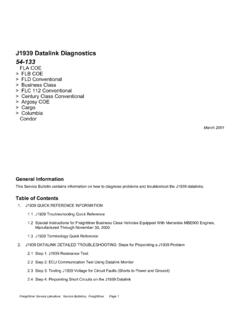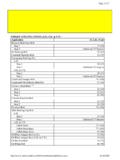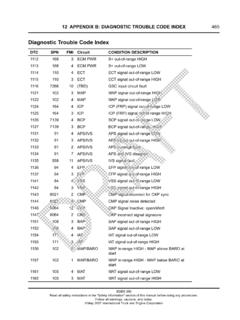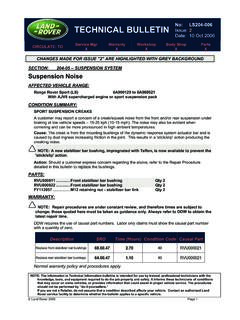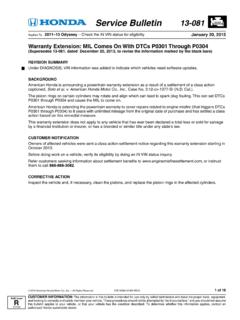Transcription of EVAP SYSTEM MONITOR DRIVE CYCLE INSTRUCTIONS - …
1 evap SYSTEM MONITOR DRIVE CYCLE INSTRUCTIONS . Do not turn off the ignition switch during the test procedure. All Onboard Diagnostic Monitors are cleared when the battery is disconnected or when the Powertrain Control Module (PCM) is cleared with the Scan Tool. This DRIVE CYCLE can be used to determine if the Readiness code for this MONITOR will complete, and if the MIL will remain off after the vehicle is driven. Operating Ranges: When a range of values is provided, try to operate the vehicle in the middle of the range. For example, if the vehicle speed range calls for 45-55 mph, DRIVE the vehicle as close as possible to 50 mph.
2 If the engine speed should be 1,000-2,000. rpm, try to operate the engine at 1,500 rpm. Scan Tool Data: There are certain Parameter Identification (PID) values that must be within range before this MONITOR will "run". It can be helpful to pull up those PID items on the Scan Tool so an assistant can view them during testing. evap SYSTEM MONITOR PRETEST CONDITIONS. Engine running with the ECT signal over 176 F; then ignition switch turned off. Engine started (cold): Requires a key "off" period of 8 hours. The key-off period can be shortened to 3 hours using the Scan Tool factory "Bypass Procedure". MIL is off. No Emission related DTC's are present Accessories turned off (A/C, headlights, blower fan and rear window defroster).
3 IAT sensor signal from 10-100 F at startup Fuel level from 15-85%. TEST PROCEDURE. 1. Connect the Scan Tool to the data link connector (DLC). Use the Scan Tool to clear any stored DTC's and to reset the Onboard Diagnostic Monitors. Bring up the Readiness Code for the evap SYSTEM MONITOR . 2. Start the engine (cold); IAT PID from 40-100 F (this step requires a key "off" period of at least 8 hours). 3. Accelerate at part-throttle to 38-65 mph and maintain that speed for 2 minutes. Note that this step must occur within 4-10 minutes from a cold engine startup (if the DRIVE CYCLE does not begin within 10 minutes of a cold engine startup, turn the key off to reset the timer and then restart the engine).
4 Then decelerate back to 0 mph without touching the brake pedal or the clutch pedal on models with manual transmission. Allow the engine to run at idle speed for 20 seconds. Bring the vehicle to a stop in a safe place, but do not turn off the ignition key. 4. Check the status of the Readiness code for the evap SYSTEM MONITOR . It should change to YES. If it does, perform any additional driving under the conditions required to run the remainder of the monitors. If the Readiness code does not change to YES, check for any Pending codes in the Generic OBD II section of the Scan Tool. If no Pending codes are set, and the status did not change to YES, return to step 3 and repeat the test procedure.
5 EGR SYSTEM MONITOR DRIVE CYCLE INSTRUCTIONS . Do not turn off the ignition switch during the test procedure. All Onboard Diagnostic Monitors are cleared when the battery is disconnected or when the Powertrain Control Module (PCM) is cleared with the Scan Tool. This DRIVE CYCLE can be used to determine if the Readiness code for this MONITOR will complete, and if the MIL will remain off after the vehicle is driven. Operating Ranges: When a range of values is provided, try to operate the vehicle in the middle of the range. For example, if the vehicle speed range calls for 45-55 mph, DRIVE the vehicle as close as possible to 50 mph.
6 If the engine speed should be 1,000-2,000. rpm, try to operate the engine at 1,500 rpm. Scan Tool Data: There are certain Parameter Identification (PID) values that must be within range before this MONITOR will "run". It can be helpful to pull up those PID items on the Scan Tool so an assistant can view them during testing. EGR SYSTEM MONITOR PRETEST CONDITIONS. MIL is off No Emission related DTC's are present ECT sensor signal more than 165 F. IAT sensor signal more than 50 F. Perform the Adaptive Memory Produce DRIVE Mode - Engine speed from 2,500-3,500. rpm in Park or Neutral under no-load conditions for 15 seconds, than back to idle speed for 30 seconds.
7 TEST PROCEDURE. 1. Connect the Scan Tool to the data link connector (DLC). Use the Scan Tool to clear any stored DTC's and to reset the Onboard Diagnostic Monitors. Bring up the Readiness Code for the EGR SYSTEM MONITOR . 2. Start the engine and allow it to run until the ECT PID reaches at least 165 F. 3. Accelerate to a speed of 49-57 mph. Maintain that speed for one minute. Then decelerate back to idle speed and maintain that speed for 20 seconds. Bring the vehicle to a stop in a safe place, but do not turn off the ignition key. 4. Check the status of the Readiness code for the EGR SYSTEM MONITOR . It should change to YES.
8 If it does, perform any additional driving under the conditions required to run the remainder of the monitors. If the Readiness code does not change to YES, check for any Pending codes in the Generic OBD II section of the Scan Tool. If no Pending codes are set, and the status did not change to YES, return to step 3 and repeat the test procedure.



